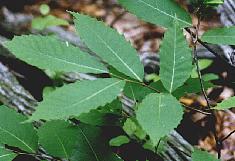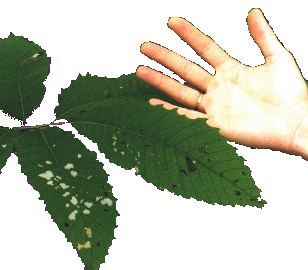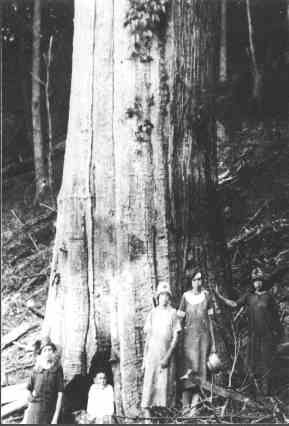Researched and Written By Judy C. Treadwell, March, 1996

Castanea dentata (American Chestnut) was once a native tree that grew from southern Maine across the Midwest to Michigan, down through Indiana and Illinois, and south to Alabama and Mississippi, and eastward into the Appalachians. The American Chestnut was cultivated in 1800 and was once considered to be the queen of the eastern American forest. With massive, wide-spreading branches and a deep broad-rounded crown, the American Chestnut was known to reach a height of 100 feet. Its greatest size was reached in the southern Appalachians. Chestnuts grew in the eastern forests along with several species of oak, hickory, maple, and birch. It was commonly found on mountains, hills, and slopes in gravelly or rocky, well-drained glacial soils.
The flowers of the American Chestnut appeared in June- July, producing a spectacular display of creamy-yellow blossoms and were strongly scented. The flowers were similar to those of the Chinese Chestnut, Castanea mollissima. The fruits ripened and dropped after the first frost. The fruit was much smaller and more flavorful than its Asian counterpart. The nuts of the American Chestnut were large, sweet, and highly desired by people, deer, squirrels, and chipmunks. In the days before the Chestnut blight, the tree reproduced abundantly by seeds and sprouts, had few insect enemies, and competed well with the other trees of the forest. Today, the American Chestnut is known only in memory because the young American chestnut trees rarely survive long enough to produce flowers and fruits.


Chestnut Trees of approximately 20 feet in diameter dwarf lumberjacks in this turn-of-the-century photograph from the Forest History Society, Inc.
For the people of the southern Appalachians, the American Chestnut was economically important. The reddish-brown wood was lightweight, soft, easy to split, very resistant to decay; and it did not warp or shrink. Because of its resistance to decay, industries sprang up throughout the region to use wood from the American Chestnut for posts, poles, piling, railroad ties, and split-rail fences. Its straight-grained wood was ideal for building log cabins, furniture, and caskets. Split-rail fences made from the American Chestnut can still be found along country roads throughout the northeast United States and the southern Appalachians. The fruit that fell to the ground was an important cash crop. Families raked up chestnuts by the bushels and took wagon loads of them to sell in nearby towns. The people even cooked the chestnuts for their own use. The bark and wood were rich in tannic acid which provided tannins for use in the tanning of leather. More than half of the vegetable tannin used by the American leather industry at the turn of the century came from the American Chestnut. So important was the American Chestnut in the southern Appalachians that some of the major timber operations became subsidiaries of leather companies which were organized to harvest other species for lumber on land bought to insure supplies of chestnut tannin extract. In addition, the American Chestnut was a graceful shade tree found in city squares and on the rural homestead.
Around 1904 a blight, Endothia parasitica, was introduced into the United States from the Orient. Commonly known as the Chestnut blight,Endothia parasitica was first found in the chestnut trees on the grounds of the New York Zoological Garden by Herman W. Merkel, a forester at the Bronx Zoo. It is believed that the fungus was unintentionally introduced into America from Asian chestnut trees that were imported as nursery stock. Merkle and W. A. Murrill, a mycologist on the staff of the New York Botanical Garden, identified the disease and gave it the name ofEndothia parasitica.
Endothia parasitica is a fungus that produces two types of spores: one is a dry disc which is relatively large and is dispersed by the wind; the other is much smaller and sticky and is dispersed by rain. The fungus causes swollen or sunken orange-colored cankers on the limbs and trunks of the chestnut trees. The spores enter into the tree by cracks and wounds in the bark. The fungus then spreads into the inner portion of the tree and girdles the tree. The leaves above the point of infection die, followed by the limbs. Within two to ten years the entire tree is dead. The cankers spread, encircle the stem, and kill the tree above the point of infection.
As the chestnut trees in the Bronx Zoo were killed back to the ground, the blight was beginning to spread. It spread northward into Connecticut and Massachusetts, and southward into New Jersey. Then it began to spread like wildfire through the eastern forests.
Eventually, scientific and political leaders realized that there was a threat to the very existence of the American Chestnut and to the industries that it supported. In 1911-1913, special funds were appropriated to study or combat the Chestnut blight. When magnificent shade trees were dying a far south as Philadelphia, the U.S. Congress appropriated money to enable foresters to control the blight. To guide control efforts of the blight, federal and state agencies stepped up research. Scientists in Pennsylvania proved that the blight could not be controlled by tree surgery, by chemical sprays, or by injection of fungicides. In the southern Appalachians of North Carolina a plan of control called for the cutting of an isolation strip across the mountains. Since this type of quarantine was not effective, it had to be discarded. When the blight was discovered in Georgia, foresters gave up on the effort to hold a quarantine line of battle. World War I and the evident futility of control efforts caused cuts in funds for Chestnut blight research and work after 1914. Scientists, foresters, and landowners watched help- helplessly as the Chestnut blight spread. By the mid-1920s, the blight was active in the southern Appalachian mountains, the location for most of the tannin extract industry. Within forty years most of the American Chestnut trees in the eastern United States were completely destroyed. American Chestnut trees killed by the blight comprised 50 per cent of the overall value of the eastern hardwood timber stands.
After the blight, the economic impact of the American Chestnut was softened by the native durability of the wood. Unlike most species, which when killed deteriorate in weeks or months, the dead American Chestnut stood for decades as ghost- like forests among the mixed deciduous trees. Slowly, these dead trees lost the qualities that had made them so valuable. The nut crops and the local economy that they supported were the first to go. For about ten years after the blight, nuts were still gathered from uninfected trees high in the southern Appalachians. By 1940 there was only a minor production of nuts from the sprouts and seedlings that survived. Lumber from American Chestnut trees was still available for about ten years after the blight. Often the chestnut trees that were left standing were infested with small borers which chewed pin-sized holes into the wood. This damaged wood was called “wormy chestnut” and was used for the manufacturing of picture frames and other small articles.
Travelers in areas where American Chestnut trees once grew and thrived may still see an occasional dead stand, stark and gray against the sky. But for the most part, they see only the remains of the American Chestnut as isolated stumps and root sprouts which developed when the parent tree was killed by the blight. Blighted trees almost always produce sprouts below the diseased portion, but the resulting saplings also become infected.

Though many of the chestnut trees are dead above the ground, many of them maintain living roots from which sprouts can grow. Healthy chestnut sprouts and seedlings can be seen in many places in the Smoky Mountains, but they will eventually be killed by the blight. Although the sprouts are not immune to the Chestnut blight, they do contain genetic information which is necessary for experiments aimed at breeding resistant trees. Today in the Great Smoky Mountain National Park work with several other organizations and agencies is being done to develop such a breeding program. Flowering American Chestnut sprouts from the park are being grafted onto blight resistant Chinese Chestnuts and hybrid trees. The offspring are then back-crossed with the Chinese chestnut.
Pure stands of American Chestnut had to be replaced by seed from distant sources: aspen, birch, yellow poplar, and pine. In the mountain regions, white pine and yellow poplar have the growth and potential for timber values approaching those of the American chestnut. By and large, the American Chestnut has been replaced by other useful trees, but they do not approach the chestnut in versatility or overall utility.
From a broad selection of Asian Chestnuts shipped to America, some 235,000 young trees were grown from the expedition’s collections and field tested throughout the range of the native American Chestnut species. Tragedy overtook thousands of the trees as deer, cows, and rabbits found them good for food, and weeds choked many of the trees to death. Other trees were killed during the winter because they were not as cold- hardy as the native Chestnuts. All in all, there were enough survivors to show a great deal about the suitability of Asian Chestnuts to the native habitat of the America Chestnut. Only one variety of Asian Chestnut had the qualities of a timber tree and appears to be promising. Many of the Asian Chestnuts were blight resistant and eventually produced flowers for breeding programs. Over the decades, scientists have carried out breeding work. Pollen from surviving American Chestnuts is used to fertilize flowers of selected imports. The nuts from successful crossings were germinated and seedlings were nurtured over a 10- to 20-year period until they reproduced their own seed. These seeds were then used to grow seedlings for plantings to learn if they had inherited the needed genes for blight resistance. During this time, the young trees demonstrated whether they had inherited good form, growth capacity, and climate hardiness. Only by growing and observing the offspring of a species can scientists determine how well trees transmit the good characteristics of their ancestors. Then back-crossing and interbreeding takes place to develop strains that retain hardiness and other desirable qualities as well as a blight resistant variety of American Chestnut. There are few tangible results from nearly fifty years of breeding programs. The yield is perhaps a dozen promising strains. Some of the varieties show blight resistance, good forest tree form, and acceptable growth rates. But none of these varieties has been adequately tested or are available for planting as the long- sought blight resistant chestnut tree.
There are some systemic fungicides which appear promising for Chestnut blight in isolated trees. The recent discovery of a nonvirulent strain of the Chestnut blight which causes disease remission when inoculated into diseased trees offers hope that the American Chestnut may be revived. This nonvirulent strain of the blight is essentially a “blight of the blight” that spreads through trees in the wild and weakens the original blight, thus allowing the tree to survive. The nonvirulent strain was first found in the European Chestnut species. Recent tests done in Connecticut and Michigan have shown that the nonvirulent strain appears to be spreading to the American Chestnut.
This article is made possible by NCNatural.com. Your On-Line guide to North Carolina Outdoors, Entertainment & Culture.
Home: Flooring: Antique Wormy Chestnut Flooring: American Chestnut History
All flooring is priced unfinished. For finishing options please contact our sales department.
Please let us prepare a free custom quote to best fit your project: Online Form or 800-333-7610

